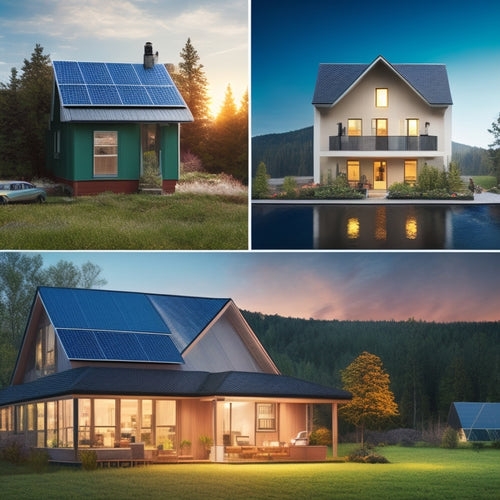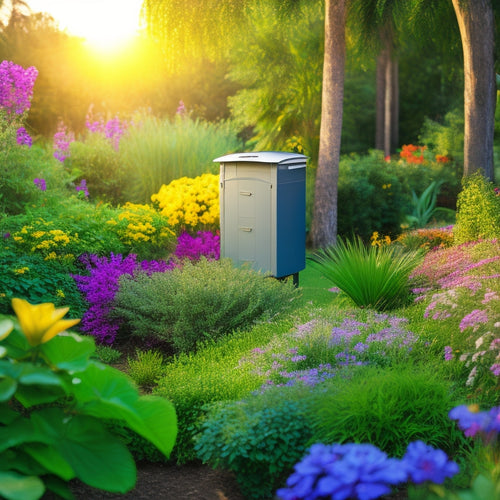
10 Off-Grid HVAC Optimization Tips for Eco-Conscious Homes
Share
You're taking a significant step towards energy independence by optimizing your HVAC system for off-grid living, and with the right strategies, you can reduce your carbon footprint while maintaining a comfortable and healthy indoor environment. Insulation, air sealing, and smart thermostats are just the beginning - you can also investigate energy-efficient modes, natural cooling methods, and ductwork improvements to maximize savings. By scheduling regular maintenance and considering zoning and energy audits, you'll be well on your way to a highly optimized HVAC system. As you continue to prioritize eco-friendly living, you'll uncover even more innovative solutions to achieve a sustainable, off-grid lifestyle.
Key Takeaways
- Proper insulation and air sealing are crucial for energy conservation and reducing carbon footprint in off-grid homes.
- Smart thermostats with automated control and real-time monitoring enhance energy efficiency and allow for user adaptation.
- Implementing efficient cooling strategies like ceiling fans, natural cooling methods, and shading techniques reduce HVAC dependency.
- Regular maintenance, system upgrades, and continuous improvement through energy audits are essential for optimal HVAC performance.
- Zoning and scheduling strategies can maximize energy savings by heating or cooling only necessary areas of the home.
Insulate and Seal Air Leaks
You'll be surprised at how much energy is wasted when your off-grid home lets heat escape or allows cold air to seep in.
Insulation and air sealing are vital to maintaining a comfortable temperature while minimizing your carbon footprint. Conduct an air leak detection using thermal imaging to identify areas where heat is escaping. Check for gaps around windows, doors, and electrical outlets.
When evaluating energy needs and infrastructure, renewable energy solutions can also play a significant role in reducing your carbon footprint. Seal these openings with caulk, spray foam, or weatherstripping.
Confirm your attic, walls, and floors are well-insulated to prevent heat loss. By sealing air leaks and insulating your home, you'll reduce energy consumption, lower your energy bills, and enjoy a more sustainable lifestyle.
Optimize Thermostat Settings
You can greatly reduce your off-grid HVAC system's energy consumption by optimizing your thermostat settings.
In the summer, implement summer saving strategies like raising the temperature by a few degrees when you're away or sleeping to minimize energy waste.
By activating energy efficiency modes, such as auto-changeover or smart recovery, you can further minimize your system's environmental footprint.
Additionally, it's crucial to select energy-efficient equipment to reduce operating costs and energy losses.
Regular monitoring and maintenance can also guarantee your system runs smoothly and efficiently.
Summer Saving Strategies
Optimize your thermostat settings to slash your energy bills and carbon footprint this summer. By incorporating passive cooling strategies, you can reduce your reliance on air conditioning.
Employ thermal mass to absorb heat during the day and release it at night. Implement shading techniques, such as summer shading, to block direct sunlight. Conduct energy audits to identify areas for improvement.
Consider humidity control, evaporative cooling, and green roofing to reduce heat gain. Apply reflective surfaces to minimize heat island effects. Enhance outdoor living with landscaping strategies that promote natural ventilation.
By leveraging renewable energy solutions, homeowners can further reduce their carbon footprint and energy bills. Additionally, achieving energy independence through solar power can greatly minimize reliance on the grid.
Apply window films to reduce heat gain and improve air quality. Finally, guarantee proper summer ventilation to maintain a comfortable indoor environment.
Energy Efficiency Modes
By strategically programming your thermostat, you can access significant energy savings and reduce your environmental impact. This is especially important in off-grid homes where energy independence is vital.
In fact, solar-powered energy can reduce grid reliance and carbon footprint, making it an attractive option for eco-conscious homeowners.
To maximize energy efficiency, consider the following modes:
- Energy-saving mode: Automatically adjusts temperature settings to optimize energy consumption.
- Eco-mode: Employs passive cooling techniques, such as natural ventilation, to reduce the load on your HVAC system.
- Smart scheduling: Learns your daily schedule to optimize heating and cooling when you need it most.
- Geofencing: Adjusts temperature settings based on your location, ensuring energy isn't wasted when you're away.
- Energy monitoring: Provides real-time energy usage data, helping you identify areas for improvement and optimize your energy saving technologies.
Upgrade to Smart Thermostats
You can take your off-grid HVAC system to the next level by upgrading to smart thermostats, which offer significant energy efficiency gains and automated temperature control.
Additionally, incorporating solar-powered charging solutions solar hubs can further reduce your carbon footprint and reliance on traditional power sources.
With a smart thermostat, you'll be able to optimize your heating and cooling usage, reducing your carbon footprint and saving energy.
Plus, you'll have real-time monitoring capabilities, allowing you to keep tabs on your system's performance and make adjustments on the fly.
Energy Efficiency Gains
Your off-grid HVAC system can reap significant energy efficiency gains by upgrading to smart thermostats, which are designed to learn your schedule and preferences to optimize heating and cooling.
This upgrade can help you reduce your energy consumption and carbon footprint.
By integrating smart thermostats into your off-grid HVAC system, you can:
- Optimize your heating and cooling usage based on your daily schedule
- Reduce energy waste through automated temperature adjustments
- Utilize passive design principles to minimize heating and cooling needs
- Identify areas for improvement through detailed energy audits
- Enjoy increased freedom and independence from the grid with reduced energy reliance
Automated Temperature Control
Smart thermostats take energy efficiency to the next level by introducing automated temperature control, allowing your off-grid HVAC system to fine-tune its performance in real-time.
By upgrading to a smart thermostat, you'll gain more precise control over your home's temperature, humidity, and energy usage. This integration enables your system to adjust to changing environmental conditions, ensuring peak performance and reduced energy waste.
With smart home integration, you can remotely monitor and adjust your thermostat, receiving notifications when your system needs maintenance or enhancement.
Additionally, advanced humidity control features help maintain a comfortable indoor climate, reducing the risk of mold growth and improving air quality.
Real-Time Monitoring Capabilities
Real-time monitoring capabilities enable off-grid HVAC systems to respond promptly to changing environmental conditions, optimizing energy efficiency and indoor climate control.
By upgrading to smart thermostats, you can tap into advanced sensor technology and data analytics to gain significant understanding of your system's performance.
- Receive real-time alerts and performance tracking updates through a user-friendly interface
- Monitor energy consumption and identify areas for improvement
- Employ system diagnostics and predictive maintenance to minimize downtime
- Enjoy remote access to your system, allowing you to make adjustments from anywhere
- Integrate environmental sensors to optimize your system's response to outdoor conditions
Install Radiant Barrier Systems
By adding a radiant barrier system to your off-grid HVAC setup, you'll be taking an important step towards slashing your energy consumption and reducing your carbon footprint.
This innovative solution works by reflecting heat rather than absorbing it, minimizing the amount of energy needed to cool your home. As a result, you can enjoy significant energy savings while maintaining a comfortable indoor climate.
Radiant barrier systems are particularly effective in warm climates, where they can reduce cooling costs by up to 10%.
Use Ceiling Fans Efficiently
As you optimize your off-grid HVAC system, consider another key component that can greatly impact your energy efficiency: ceiling fans. By using them efficiently, you can reduce your reliance on traditional heating and cooling methods, thereby decreasing your carbon footprint.
To maximize the benefits of ceiling fans, follow these tips:
-
Run ceiling fans in a counterclockwise direction during summer to push cool air down, making your home feel cooler.
-
Reverse the fan direction to clockwise in winter to circulate warm air, reducing the need for heating.
-
Adjust fan speed according to the season and your personal comfort level.
-
Install ceiling fans in areas where they can circulate air most effectively, such as living rooms and bedrooms.
-
Consider upgrading to energy-efficient ceiling fans with DC motors, which use considerably less power than traditional AC motors.
Improve Ductwork and Ventilation
Optimize your off-grid HVAC system's performance by tackling an essential but often overlooked aspect: ductwork and ventilation.
You'll be surprised at how much energy you can save by ensuring your ducts are properly sealed and insulated. Consider investing in advanced duct sealing techniques, such as aerosol-based sealants or manual sealing with mastic, to minimize air leaks.
A well-designed ventilation system is also important for maintaining indoor air quality and reducing moisture buildup. When designing your ventilation system, focus on creating a balanced airflow that minimizes heat loss and maximizes natural ventilation.
Add Solar Powered Ventilation
You can utilize the power of the sun to optimize your off-grid HVAC system by incorporating solar powered ventilation.
This eco-friendly approach not only reduces your reliance on fossil fuels but also provides natural cooling methods and year-round fresh air.
Solar Ventilation Benefits
Solar panels on your off-grid roof can do more than just generate electricity - they can also power a ventilation system that reduces your HVAC load and enhances indoor air quality.
By integrating solar-powered ventilation into your off-grid home, you can utilize the power of renewable energy to create a healthier, more comfortable living space.
- You'll reduce your reliance on fossil fuels and lower your carbon footprint
- Solar air systems can provide a consistent flow of fresh air, even on cloudy days
- Renewable energy-powered ventilation reduces the load on your HVAC system, saving you energy and money
- Solar ventilation systems are quiet, reliable, and require minimal maintenance
- By optimizing your ventilation system with solar power, you'll enjoy improved indoor air quality and a reduced risk of moisture buildup
Natural Cooling Methods
By leveraging natural cooling methods, you can further reduce your off-grid home's reliance on HVAC systems and create a more sustainable living space. These methods not only decrease your energy consumption but also provide a more comfortable and healthy indoor environment. Here are some effective natural cooling methods to contemplate:
| Method | Description |
|---|---|
| Passive Design | Orientation, insulation, and window placement to minimize heat gain |
| Thermal Mass | Using materials with high thermal mass to absorb and release heat |
| Evaporative Cooling | Using water features to cool the air through evaporation |
Additionally, contemplate incorporating green roofs, cross ventilation, earth sheltering, window shading, and landscaping strategies to enhance natural airflow and reduce the need for HVAC systems. By combining these methods, you can create a self-sufficient and eco-friendly home that's truly off the grid.
Year-Round Fresh Air
Integrate a solar-powered ventilation system into your off-grid home to maintain a steady supply of fresh air throughout the year, regardless of the season.
This system utilizes the power of the sun to provide a consistent flow of fresh air, ensuring ideal indoor air quality. By doing so, you'll create a healthier living space while minimizing your reliance on non-renewable energy sources.
-
Improve fresh air circulation by installing solar-powered vents in strategic locations
-
Reduce indoor air pollution by removing stale air and introducing fresh air
-
Increase energy efficiency by utilizing natural ventilation techniques
-
Enhance overall indoor air quality by reducing moisture and humidity levels
-
Create a more comfortable living space by maintaining a consistent temperature and air flow
Plant Trees for Natural Shade
How much can strategically planted trees reduce your cooling costs? By optimizing tree placement, you can utilize the shade benefits to slash your HVAC expenses.
| Tree Placement | Shade Benefits |
|---|---|
| South and west sides | Blocks direct sunlight, reducing heat gain |
| East side | Provides morning shade, cooling your home before peak sun hours |
| North side | Allows winter sunlight to warm your home, reducing heating needs |
| Strategically placed near HVAC units | Reduces equipment temperature, increasing efficiency |
Implement Zoning and Scheduling
Optimizing your HVAC system's performance involves more than just clever tree placement. You need to take control of your heating and cooling usage to maximize efficiency. Implementing zoning and scheduling techniques is an essential step in achieving this goal.
By dividing your home into separate zones, you can heat or cool only the areas that need it, reducing energy waste and increasing overall efficiency.
-
Zoning benefits include reduced energy consumption, lower energy bills, and extended equipment lifespan.
-
Create schedules that align with your daily routines, such as turning off the HVAC system when you're away or sleeping.
-
Use smart thermostats to automate your scheduling and zoning efforts.
-
Consider installing dampers or zone valves to control airflow to specific zones.
-
Monitor and adjust your zoning and scheduling strategies regularly to guarantee peak performance.
Regularly Maintain HVAC Systems
By taking control of your heating and cooling usage through zoning and scheduling, you've already made considerable progress in reducing energy waste and enhancing efficiency.
Now, it's time to take it to the next level by regularly maintaining your HVAC systems. This involves replacing filters every 1-3 months to guarantee ideal airflow balance and system performance.
Schedule seasonal checks to inspect refrigerant levels, clean ducts, and identify potential issues before they become major problems.
Consider equipment upgrades to enhance energy efficiency and reduce your carbon footprint.
Finally, don't forget to schedule technician inspections to confirm your system is running at its best.
Frequently Asked Questions
Can I Use a Programmable Thermostat With a Zoning System?
You can definitely use a programmable thermostat with a zoning system, leveraging zoning benefits like increased efficiency and customized comfort while ensuring thermostat compatibility for seamless integration and ideal performance in your off-grid eco-haven.
Do Radiant Barrier Systems Work in Cold Climates?
As you wrap your home in a radiant barrier, imagine a thermal blanket shielding your sanctuary from frigid winds. But, you wonder, do these systems really work in cold climates? Yes, they do, and their effectiveness shines when paired with proper insulation and air-tight construction.
Can I Install a Solar Powered Ventilation System Myself?
You can install a solar-powered ventilation system yourself, but make certain you've got the necessary skills and permits. Start by sizing your solar panel installation correctly, then follow DIY ventilation guides, and don't hesitate to consult local experts if you're unsure.
How Often Should I Clean My HVAC System's Air Filters?
You should clean your HVAC system's air filters every 1-3 months, depending on usage, to guarantee proper filter maintenance and maintain good air quality; dirty filters reduce efficiency and compromise indoor air quality, affecting your health and freedom.
Are Ceiling Fans Effective in Heating During Winter?
You'll be surprised to find that ceiling fans can be quite effective in heating during winter, as they circulate warm air, reducing heat loss and energy consumption, allowing you to cut back on your heating bill and carbon footprint.
Related Posts
-

What Does Your Home Energy Audit Report Reveal?
Your home energy audit report reveals a detailed analysis of your energy consumption patterns, highlighting areas of ...
-

Why Vertical Gardens Reduce Home Energy Consumption
By incorporating a vertical garden into your home design, you'll reduce energy consumption through natural insulation...
-

Why Choose Solar Composting Toilets for Your Home?
By choosing a solar composting toilet for your home, you'll greatly reduce your environmental impact, slashing your w...


